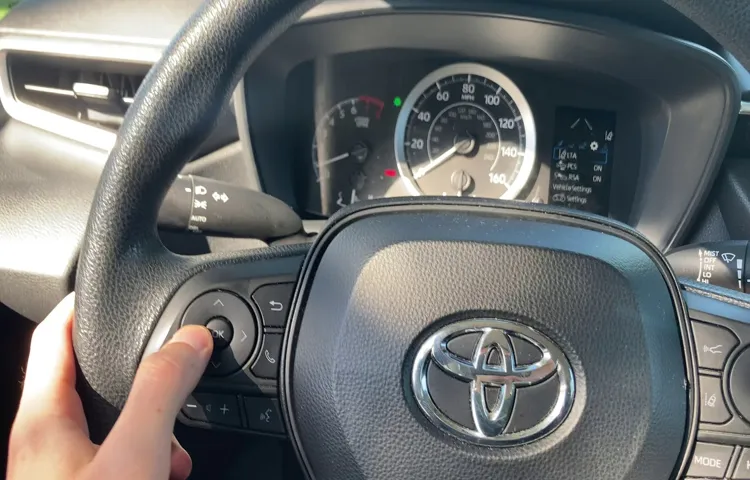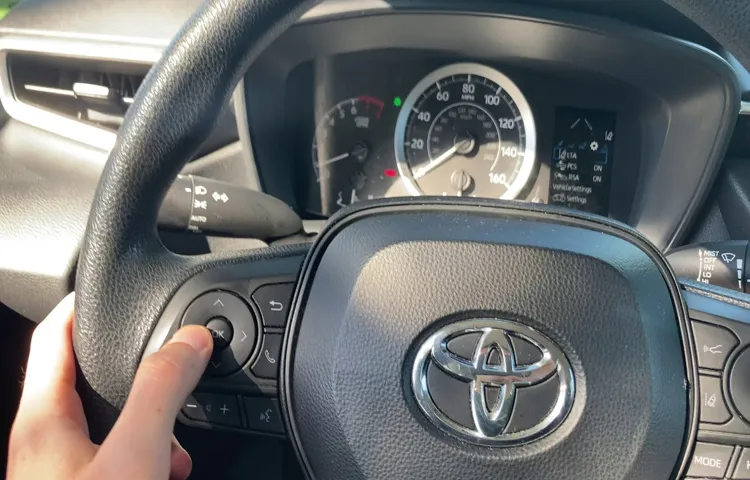As a Toyota Corolla owner, you want to keep your car in the best shape possible. One crucial aspect of car maintenance is keeping your tires properly inflated. Not only can under-inflated tires affect your car’s performance, but they can also be dangerous.
So, how do you check the tire pressure on your Toyota Corolla? Don’t worry; it’s easier than you think! In this blog post, we’ll guide you through the process of checking your Toyota Corolla’s tire pressure step-by-step. We’ll also cover why proper tire pressure is essential and what can happen if you neglect it. So, let’s dive in and ensure your Toyota Corolla’s tires are in top-notch condition!
Table of Contents
Why You Should Check Your Tire Pressure
As a responsible car owner, checking your tire pressure is something that should be on your regular to-do list. When it comes to a Toyota Corolla, checking the tire pressure is a relatively simple task. First, you should locate the tire pressure sticker on the driver’s side door jamb or in the owner’s manual.
This will tell you the recommended tire pressure for your vehicle. Using a tire pressure gauge, remove the valve cap from the tire and press the gauge on the valve stem. The gauge will show the current PSI (pounds per square inch) reading which should match the recommended pressure.
If it’s too low, use an air compressor to inflate the tire until it reaches the correct level. Maintaining proper tire pressure not only improves fuel efficiency but also ensures your vehicle handles well and promotes even wear on your tires, potentially saving you money in the long run. By taking a few minutes to regularly check your Toyota Corolla’s tire pressure, you can enjoy safer and more cost-effective driving.
Safety
Tire pressure is crucial to ensure that your vehicle operates safely and economically. Properly inflated tires help in maintaining optimum traction, reduce the risk of blowouts, and improve fuel efficiency. It’s important to check your tire pressure regularly, as underinflated tires can cause poor handling, uneven wearing, and reduce the life of your tires.
Moreover, overinflated tires contribute to slipping and skidding during wet or icy conditions. Checking your tire pressure is a simple task that you can do yourself with a tire pressure gauge and a little bit of knowledge. Make sure to check the recommended tire pressure stated in your vehicle’s manual or the driver’s doorjamb, rather than relying on the pressure stamped on the sidewall of the tire.
Remember, taking a few minutes to check your tire pressure can make a significant difference in your car’s safety and your wallet’s health. So, next time when you hit the road, ensure that your tires are correctly inflated- it could save your life!

Fuel Economy
Fuel economy is an important aspect of car ownership that many people overlook. One of the easiest ways to improve your car’s fuel efficiency is to regularly check your tire pressure. When your tires are under-inflated, they create more friction with the road, which reduces your car’s fuel economy.
In fact, according to the US Department of Energy, you can improve your gas mileage by up to 3% just by keeping your tires inflated to the recommended pressure. Not only will this save you money at the gas pump, but it will also help reduce your carbon footprint.
So, take a few minutes every month to check your tire pressure and keep your car running smoothly.
Tools You Will Need
If you own a Toyota Corolla, it’s important to regularly check your tire pressure to ensure your car is operating at peak performance. To do so, you will need a few tools, including a tire pressure gauge, a tire inflator or air compressor, and access to the valve stem on each tire. Start by locating the recommended tire pressure for your specific Toyota Corolla model, typically found in the car’s owner’s manual or on a sticker inside the driver’s side door.
Once you have your tire pressure gauge, unscrew the valve cap on one tire and press the gauge onto the valve stem until you hear a hissing noise. The gauge will show you the tire’s current pressure, and if it’s below the recommended level, use your tire inflator or air compressor to add air until the pressure matches the recommended amount. Repeat this process for each tire, being sure to replace the valve caps once you’re finished.
Checking your tire pressure regularly can not only improve the performance of your car but also ensure your safety on the road.
Tire Pressure Gauge
When it comes to maintaining your vehicle, it’s important not to overlook the importance of monitoring your tire pressure. This simple task can have a big impact on your car’s performance and fuel efficiency. To perform this task, you’ll need a tire pressure gauge.
These tools are relatively inexpensive and can be found at any auto parts store or online retailer. When selecting a tire pressure gauge, look for one that is easy to read and accurate. A digital gauge may be more precise, but a manual gauge can be just as effective if used correctly.
It’s also crucial to make sure your gauge is calibrated properly before using it. By having a reliable tire pressure gauge on hand, you can ensure that your tires are always in good condition and your vehicle is running smoothly.
Air Compressor
If you’re planning on using an air compressor, it’s important to have the right tools to get the job done. First and foremost, you’re going to need an air hose to connect the compressor to your tools or equipment. Make sure to choose a durable and flexible hose that can withstand high pressure and won’t easily kink or tangle.
You’ll also need a variety of air fittings, such as couplers and plugs, to connect the hose to your tools. It’s important to choose the right fittings for your specific tools, as there are different sizes and types available. In addition, a regulator and pressure gauge will help you control the air pressure and ensure that you’re not exceeding the recommended limits for your tools.
Lastly, don’t forget to have appropriate safety gear, such as goggles and ear protection, when using your air compressor. With the right tools and precautions in place, you can confidently tackle any project with your air compressor.
Steps for Checking Tire Pressure
If you’re a Toyota Corolla owner, regular tire pressure checks are crucial to keep your vehicle running smoothly and safely. The good news is that checking tire pressure is a simple process that can be done at home with a few tools. Begin by finding the recommended tire pressure for your Corolla, which can be found in the owner’s manual or on a sticker located on the driver’s side door jamb.
Once you’ve located this information, remove the valve cap from each tire and use a tire pressure gauge to check the pressure level. If the pressure is too low, add air until it matches the recommended level. If it’s too high, release some air until it reaches the correct level.
Repeat this process for all tires, including the spare. It’s a good idea to check your tire pressure monthly, or before long trips, to ensure optimal handling, fuel efficiency, and tire life. With these simple steps, you can keep your Toyota Corolla running smoothly and safely on the road.
Step 1: Check the recommended tire pressure
If you want to ensure your vehicle runs smoothly and safely, checking your tire pressure is essential. The first step in this process is to check the recommended tire pressure. This information can usually be found in your vehicle’s owner’s manual or on a sticker inside the driver’s side door jamb.
It’s important to note that the recommended tire pressure may vary depending on the type of tire you have installed or the load you’re carrying. Once you know the recommended pressure, you can use a tire pressure gauge to check the pressure of each tire. If the pressure is too low or too high, you should adjust it accordingly to ensure optimal performance and prevent premature wear and tear.
By taking the time to check your tire pressure regularly, you can improve your vehicle’s fuel efficiency, reduce the risk of accidents, and ultimately save money in the long run.
Step 2: Park vehicle on level ground
Checking Tire Pressure Before checking the tire pressure, the first step is to park your vehicle on a level ground. This is essential because if your car is parked on an uneven surface, it can create difficulties in getting an accurate tire pressure reading. Once you have found a level surface, turn off the engine and put the car in park.
If you are uncertain of where to check the specific tire pressure settings, you can find the information in the owner’s manual or on the inside of the driver’s side door. Once you locate this information, remove the valve cap from the tire and attach the tire pressure gauge to the valve stem. Push the gauge onto the stem until you no longer hear any air escaping, and then quickly remove it.
You can now read the tire pressure display on the gauge, which will indicate whether your tire pressure is too high or too low. It is essential to have the correct tire pressure to experience good handling, increased fuel efficiency, and longer tire life. Regularly performing tire pressure checks is necessary for overall vehicle maintenance and safety.
Step 3: Remove tire valve cap
As you prepare to check your tire pressure, the first step is to remove the tire valve cap. This small, usually black cap covers the valve stem, where you will attach the tire pressure gauge. It’s important to remove the cap gently and not misplace it.
The cap keeps dust, dirt, and moisture from entering the valve stem, which could cause issues down the line. By removing it carefully, you protect the valve stem and ensure an accurate reading. Once you remove the cap, set it to the side where it won’t get lost.
If you do happen to misplace it, replacements are relatively inexpensive and easily found at an auto parts shop. Whether you’re checking your tire pressure personally or having it done professionally, make sure the valve cap is removed first to ensure an accurate reading.
Step 4: Attach tire pressure gauge to valve stem
When it comes to maintaining your vehicle, checking tire pressure regularly is critical. Overinflated or underinflated tires can lead to a variety of problems, including reduced fuel efficiency, poor handling, and increased wear and tear on the tires. To check your tire pressure, start by removing the valve stem cap and attaching the tire pressure gauge to the valve stem.
Make sure the gauge is firmly in place before taking a reading. If you’re not sure what pressure your tires should be, consult your vehicle owner’s manual or the tire manufacturer’s specifications. Once you’ve taken a reading, compare it to the recommended pressure and adjust accordingly.
It’s also a good idea to check your tire pressure monthly and before long road trips to ensure your vehicle is operating at its best. By keeping your tires properly inflated, you’ll not only save on gas but also help keep yourself safe on the road.
Step 5: Read the tire pressure gauge
Once you’ve placed the tire pressure gauge onto the valve stem, take a quick look at the reading. The gauge should provide you with a numerical value that represents the tire’s air pressure in pounds per square inch (PSI). If the number is within the recommended PSI range, you’re good to go.
If not, you’ll need to add or release air as necessary to get the tire to the right pressure. Remember, having the proper tire pressure is essential for safe and efficient driving. So be sure to check your tire pressure regularly and before any long trips.
Trust me, it’s better to be safe than sorry.
Step 6: Repeat for all tires
Once you have checked the tire pressure of one tire, it’s time to repeat the process for all four. Make sure you use the same method for each one to ensure accuracy. Start by finding the valve stem again and removing the cap.
Then, attach the tire pressure gauge and take a reading. If the tire is low, use an air compressor or visit a gas station to inflate it to the recommended pressure. Remember to check both sides of each tire to ensure they are all at the proper level.
Checking your tire pressure regularly can help prevent accidents, improve gas mileage, and prolong the life of your tires. Don’t overlook this simple but important task to keep yourself safe on the road.
Step 7: Inflate or deflate tires as necessary
When it’s time to check your vehicle’s tire pressure, it’s important not to skip any steps. One crucial step in the process is inflating or deflating your tires as needed. If your tires are underinflated, they’ll wear unevenly and use up more fuel than necessary.
On the other hand, overinflated tires can be dangerous, as they’re more likely to blow out. That’s why it’s essential to check your tire pressure with a reliable gauge and add air as needed. You should also inflate or deflate your tires according to the manufacturer’s recommended pressure, which you can find in your vehicle owner’s manual or on the tire sidewall.
By taking this step, you’ll help ensure that your tires wear evenly, provide optimal traction, and last as long as possible, which can save you time, money, and headaches down the road. So, next time you’re checking your tire pressure, don’t forget to inflate or deflate as necessary. Your tires (and your wallet) will thank you!
Conclusion
In the wise words of Tom Brady, ‘Every single play, you gotta be ready for greatness.’ The same rings true for checking your Toyota Corolla’s tire pressure. It may seem like a small task, but neglecting it can lead to big problems down the road.
So, grab your trusty tire gauge, take a deep breath, and channel your inner Brady as you get ready to tackle this important maintenance task. Remember, greatness is just a tire pressure check away!”
FAQs
What is the recommended tire pressure for a Toyota Corolla?
The recommended tire pressure for a Toyota Corolla is typically 32 PSI.
How do I check the tire pressure on my Toyota Corolla?
You can check the tire pressure on your Toyota Corolla by using a tire pressure gauge on each tire and ensuring they are all at the recommended level.
Can low tire pressure affect the performance of my Toyota Corolla?
Yes, low tire pressure can affect the performance of your Toyota Corolla by reducing fuel efficiency, causing uneven tire wear, and decreasing handling and stability.
Is it safe to drive a Toyota Corolla with low tire pressure?
No, it is not safe to drive a Toyota Corolla with low tire pressure as it can lead to decreased handling and stability, and potential tire failure.
How often should I check the tire pressure on my Toyota Corolla?
It is recommended to check the tire pressure on your Toyota Corolla at least once a month.
Can I overinflate the tires on my Toyota Corolla?
Yes, overinflating the tires on your Toyota Corolla can lead to a harsher ride, uneven tire wear, and potentially cause tire failure.
What should I do if I notice a tire is losing pressure on my Toyota Corolla?
If you notice a tire is losing pressure on your Toyota Corolla, check for any visible damage or punctures in the tire. If none are found, bring the car to a mechanic to further inspect the tire and potentially repair or replace it.



